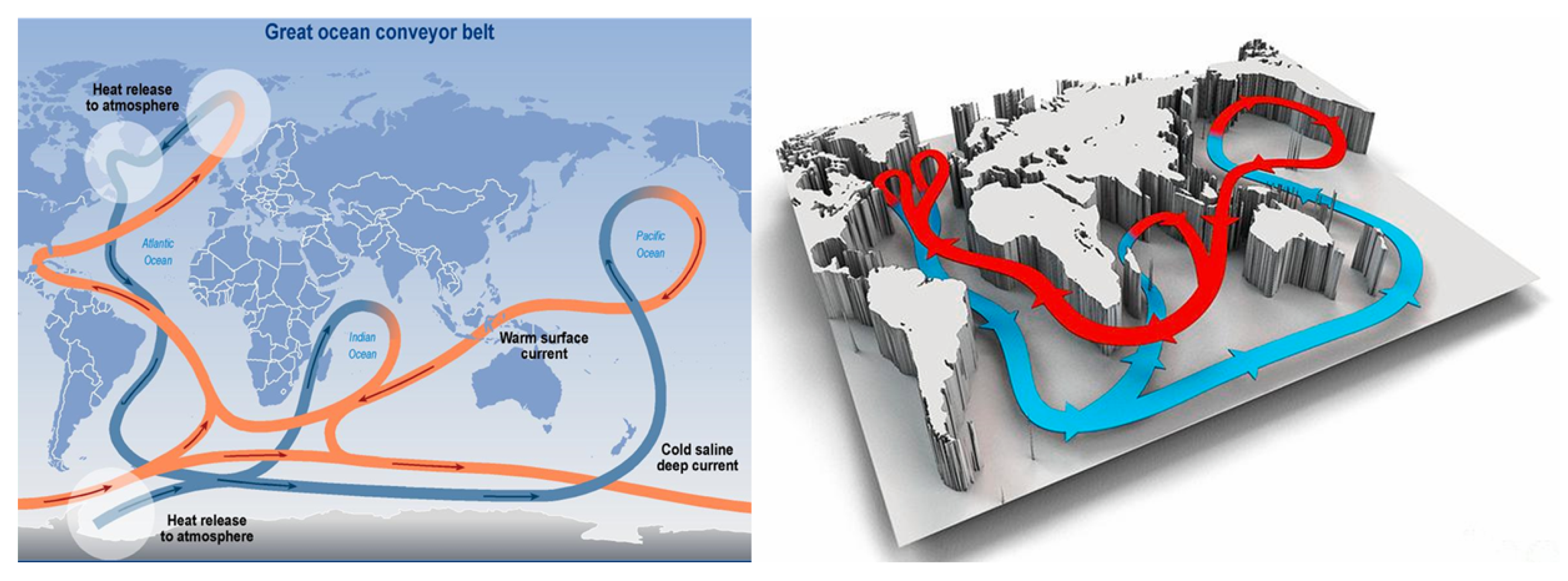Fundamentals of Climatology for Engineers: Lecture Note
Abstract
1. Introduction
1.1. Scales of Climate
- The microclimate is the local climate at a particular point location (e.g., a climate station, for instance a long-term weather or temperature station.
- The mesoclimate is the climate of a region (e.g., southern Oregon).
- The synoptic climate [7] is the climate of a large area (e.g., 1000 km to 10,000 km).
- The global climate is the climate of the planet.
1.2. Climate and Weather
2. Radiation and Energy Balance in Atmosphere and Earth’s Surface
2.1. Energy Balance
2.2. Heat Transport Process
2.3. Radiation Balance at the Surface
3. Earth’s Atmosphere
4. Earth’s Climatic Processes
4.1. Heat Transport
4.2. Atmospheric Circulation
4.2.1. Low-Level Circulation
4.2.2. Upper-Level Circulation
4.2.3. General Circulation
4.3. Global Pressure, Surface Wind Speed, and Sea Surface Temperature (SST)
4.4. Ocean Temperature and Salinity Profile
4.5. Wind-Driven Circulation and Ocean Currents
4.6. Thermohaline Circulation
5. Coupled Ocean and Atmosphere Processes
5.1. Annual Cycle and Monsoon Circulation
5.2. Tropical Cyclones
- A warm ocean surface (min 26 C to 27 C) is necessary to provide the required fluxes of water vapor and sensible heat from ocean to atmosphere.
- Since strong rotation is generated in regions of significant Coriolis force, these storms form beyond about 5 to 8 of the Equator.
- A small change of wind with height is required if the storm is to survive.
6. El Niño–Southern Oscillation
7. Aspects of Land Surface Climate
Planetary Boundary Layer
8. Climate Variability
8.1. Small-Scale Climate Variability
8.2. Drought
9. Greenhouse Effect and Global Warming
9.1. Greenhouse Effect
9.2. Natural Greenhouse Effect
9.3. Anthropogenic Greenhouse Effect
9.4. Greenhouse Gases
9.4.1. Water Vapor
9.4.2. Carbon Dioxide
9.4.3. Methane
9.4.4. CFCs
9.4.5. Nitrous Oxide
9.5. Global Warming
Potential Effects of Global Warming
10. The Pillars of Climate Change
11. Conclusions
Funding
Institutional Review Board Statement
Informed Consent Statement
Data Availability Statement
Acknowledgments
Conflicts of Interest
References
- NOAA. Climate Prediction Center: Climate Glossary; NOAA: Washington, DC, USA, 2010.
- Brekke, L.D. Climate Change and Water Eesources Management: A Federal Perspective; Diane Publishing: Darby, PA, USA, 2009. [Google Scholar]
- Oliver, J.E. Encyclopedia of World Climatology; Springer Science & Business Media: Berlin/Heidelberg, Germany, 2008. [Google Scholar]
- Sarker, S.; Veremyev, A.; Boginski, V.; Singh, A. Critical nodes in river networks. Sci. Rep. 2019, 9, 1–11. [Google Scholar] [CrossRef]
- Sarker, S. Investigating Topologic and Geometric Properties of Synthetic and Natural River Networks under Changing Climatic. Ph.D. Thesis, University of Central Florida, Orlando, FL, USA, 2021. [Google Scholar]
- Gao, Y.; Sarker, S.; Sarker, T.; Leta, O.T. Analyzing the critical locations in response of constructed and planned dams on the Mekong River Basin for environmental integrity. Environ. Res. Commun. 2022, 4, 101001. [Google Scholar] [CrossRef]
- Lee, C.; Sheridan, S. Synoptic Climatology: An Overview. Reference Module in Earth Systems and Environmental Sciences; Elsevier: Amsterdam, The Netherlands, 2015. [Google Scholar]
- NOAA. National Centers for Environmental Information: What’s the Difference between Weather and Climate? Available online: https://www.ncei.noaa.gov/news/weather-vs-climate#:~:text=Whereas%20weather%20refers%20to%20short,time%20in%20a%20specific%20area (accessed on 2 March 2022).
- Sarker, S. A Short Review on Computational Hydraulics in the context of Water Resources Engineering. Open J. Model. Simul. 2022, 10, 1–31. [Google Scholar] [CrossRef]
- Sarker, S. Essence of MIKE 21C (FDM Numerical Scheme): Application on the River Morphology of Bangladesh. Open J. Model. Simul. 2022, 10, 88–117. [Google Scholar] [CrossRef]
- NASA. What’s the Difference between Weather and Climate? Available online: https://www.nasa.gov/mission_pages/noaa-n/climate/climate_weather.html (accessed on 3 March 2022).
- Barry, R.G.; Gan, T.Y. The Global Cryosphere: Past, Present, and Future; Cambridge University Press: Cambridge, UK, 2022. [Google Scholar]
- Chen, B. Coupled Terrestrial Carbon and Water Dynamics in Terrestrial Ecosystems: Contributions of Remote Sensing. In Remote Sensing: Applications; InTech: Rijeka, Croatia, 2012; p. 223. [Google Scholar]
- NCCO. Earth’s Energy Balance. Available online: https://legacy.climate.ncsu.edu/edu/EnergyBalance (accessed on 4 March 2022).
- Chow, V.T.; Maidment, D.R.; Larry, W.M. Applied Hydrology; International Edition; MacGraw-Hill Inc.: New York, NY, USA, 1988; Volume 149. [Google Scholar]
- Ames, I.A. Carbon Sequestration and Greenhouse Gas Fluxes in Agriculture: Challenges and Opportunities; Council for Agricultural Science and Technology: Ames, IA, USA, 2011. [Google Scholar]
- NASA-FAU. The Sun’s Electromagnetic Spectrum. Available online: http://www.ces.fau.edu/nasa/module-2/radiation-sun.php (accessed on 3 March 2022).
- Sarker, T. Role of Climatic and Non-Climatic Factors on Land Use and Land Cover Change in the Arctic: A Comparative Analysis of Vorkuta and Salekhard. Master’s Thesis, The George Washington University, Washington, DC, USA, 2020. [Google Scholar]
- NASA. Earth’s Upper Atmosphere. Available online: https://www.nasa.gov/mission_pages/sunearth/science/mos-upper-atmosphere.html (accessed on 8 March 2022).
- NUS. Principles of Remote Sensing; Centre for Remote Imaging, Sensing and Processing, National University of Singapore: Singapore, 2001. [Google Scholar]
- Bryant, E.; Bryant, E.A.; Edward, B. Climate Process and Change; Cambridge University Press: Cambridge, UK, 1997. [Google Scholar]
- NASA. Earth Observatory: Heating Imbalances. Available online: https://earthobservatory.nasa.gov/features/EnergyBalance/page3.php (accessed on 14 March 2022).
- NOAA. Global Circulations. 2022. Available online: https://www.noaa.gov/jetstream/global/global-circulations (accessed on 14 March 2022).
- UCAR. A Global Look at Moving Air: Atmospheric Circulation. Available online: https://scied.ucar.edu/learning-zone/how-weather-works/global-air-atmospheric-circulation (accessed on 14 March 2022).
- Nugent, A.; DeCou, D.; Russell, S.; Karamperidou, C. Atmospheric Processes and Phenomena; UH Pressbooks, The University of Hawaii: Honolulu, HI, USA, 2019. [Google Scholar]
- Hidore, J.J.; Oliver, J.E. Climatology: An Atmospheric Science; MacMillan Publishing Co.: New York, NY, USA, 1993. [Google Scholar]
- Wang, S.Y.S.; Gillies, R. Modern Climatology; BoD–Books on Demand: Norderstedt, Germany, 2012. [Google Scholar]
- Miller, A.A. Climatology; Routledge: Abingdon-on-Thames, UK, 2019. [Google Scholar]
- Perry, A.; Thompson, R. Applied Climatology: Principles and Practice; Routledge: Abingdon-on-Thames, UK, 2013. [Google Scholar]
- Hobbs, J.E. Applied Climatology: A Study of Atmospheric Resources; Elsevier: Amsterdam, The Netherlands, 2016. [Google Scholar]
- Akbari, E.; Alavipanah, S.K.; Jeihouni, M.; Hajeb, M.; Haase, D.; Alavipanah, S. A review of ocean/sea subsurface water temperature studies from remote sensing and non-remote sensing methods. Water 2017, 9, 936. [Google Scholar] [CrossRef]
- NASA (PennState). The Global Conveyor Belt. Available online: https://www.e-education.psu.edu/earth103/node/686 (accessed on 15 May 2022).
- Wang, C. Three-ocean interactions and climate variability: A review and perspective. Clim. Dyn. 2019, 53, 5119–5136. [Google Scholar] [CrossRef]
- NOAA. The Global Conveyor Belt. Available online: https://oceanservice.noaa.gov/education/tutorial_currents/05conveyor2.html (accessed on 15 May 2022).
- NOAA. Normal Pacific Pattern, El Niño Conditions and La Niña Conditions; NOAA: Washington, DC, USA, 2014.
- Salby, M.L. Fundamentals of Atmospheric Physics; Elsevier: Amsterdam, The Netherlands, 1996. [Google Scholar]
- Reijs, V. Atmosphere Boundary Layers Influencing Atmospheric Refraction. Available online: http://www.archaeocosmology.org/eng/tropospherelayers.htm (accessed on 15 May 2022).
- UCAR. Climate Variability. Available online: https://scied.ucar.edu/learning-zone/how-climate-works/climate-variability (accessed on 15 May 2022).
- EPA. Basics of Climate Change. Available online: https://www.epa.gov/climatechange-science/basics-climate-change#:~:text=The%20greenhouse%20effect%20helps%20trap,the%20earth%20to%20warm%20up (accessed on 15 May 2022).
- NASA. Global Climate Change: What Is the Greenhouse Eeffect? Available online: https://climate.nasa.gov/faq/19/what-is-the-greenhouse-effect/ (accessed on 18 May 2022).
- UCSanDiego. The Keeling Curve. Available online: https://keelingcurve.ucsd.edu/ (accessed on 20 May 2022).
- Ash, A. What’s the Real Cause of Climate Change? What the Deep Data Reveals. 2022. Available online: https://www.youtube.com/watch?v=-skE4jCuf-w&t=22s (accessed on 22 June 2022).
- Roston, E.; Migliozzi, B. What’s Really Warming the Word? 2015. Available online: https://www.bloomberg.com/graphics/2015-whats-warming-the-world/ (accessed on 22 June 2022).
- Kennedy, C. Why Did Earth’s Surface Temperature Stop Rising in the Past Decade? 2018. Available online: https://www.climate.gov/news-features/climate-qa/why-did-Earth%E2%80%99s-surface-temperature-stop-rising-past-decade (accessed on 22 June 2022).
- UCAR. Why Earth Is Warming. Available online: https://scied.ucar.edu/learning-zone/how-climate-works/why-Earth-warming (accessed on 22 June 2022).
- NASA. Global Temperature. Available online: https://climate.nasa.gov/vital-signs/global-temperature/ (accessed on 22 June 2022).
- Our World in Data: Energy Mix. Available online: https://ourworldindata.org/energy-mix#:~:text=Globally%20we%20get%20the%20largest,still%20dominated%20by%20fossil%20fuels (accessed on 22 June 2022).
- Scott, M.; Lindsey, R. What’s the Hottest Earth’s Ever Been? 2020. Available online: https://www.climate.gov/news-features/climate-qa/whats-hottest-earths-ever-been (accessed on 22 June 2022).
- NASA. Sun-Earth. Available online: https://www.nasa.gov/mission_pages/sunearth/solar-events-news/Does-the-Solar-Cycle-Affect-Earths-Climate.html (accessed on 22 June 2022).
- NASA. Graphic: Temperature vs. Solar Activity. Available online: https://climate.nasa.gov/climate_resources/189/graphic-temperature-vs-solar-activity/ (accessed on 22 June 2022).
- NASA. Ancient Climate Events: Paleocene Eocene Thermal Maximum. Available online: https://www.e-education.psu.edu/earth103/node/639 (accessed on 22 June 2022).
- Pappas, S. Carbon Dioxide Is Warming the Planet (Here’s How). 2017. Available online: https://www.livescience.com/58203-how-carbon-dioxide-is-warming-Earth.html (accessed on 22 June 2022).
- NASA. Earth Observatory: Is Current Warming Natural? Available online: https://earthobservatory.nasa.gov/features/GlobalWarming/page4.php#:~:text=When%20the%20Sun’s%20energy%20is,but%20the%20stratosphere%20has%20cooled (accessed on 22 June 2022).
- NASA. Earth Observatory: How is Today’s Warming Different from the Past? Available online: https://earthobservatory.nasa.gov/features/GlobalWarming/page3.php#:~:text=As%20the%20Earth%20moved%20out,ice-age-recovery%20warming (accessed on 22 June 2022).
- EPA. Overview of Greenhouse Gases. Available online: https://www.epa.gov/ghgemissions/overview-greenhouse-gases (accessed on 22 June 2022).
- Our World in Data: The World Has Lost One-Third of Its Forest, but an End of Deforestation is Possible. Available online: https://ourworldindata.org/world-lost-one-third-forests (accessed on 22 June 2022).
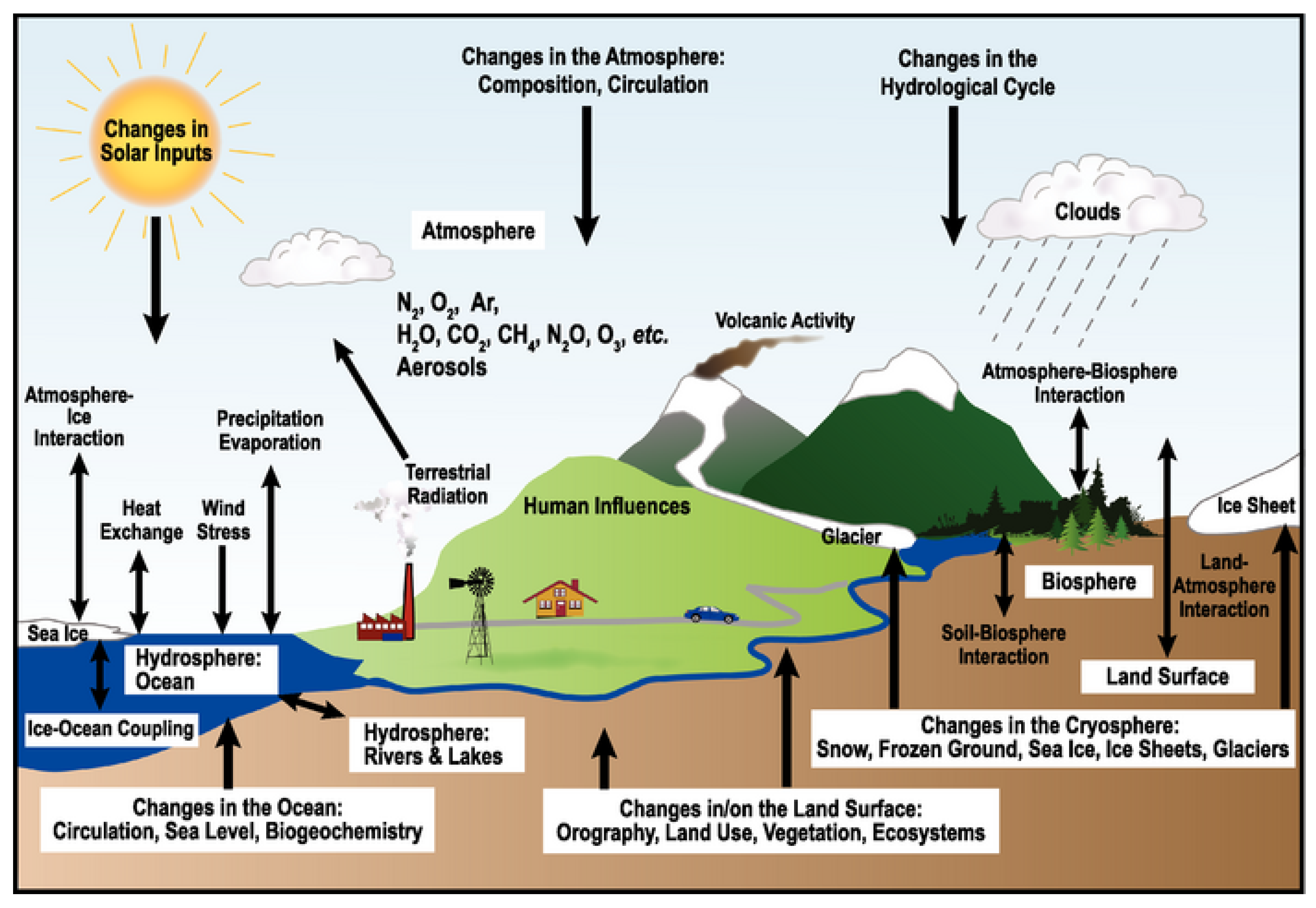
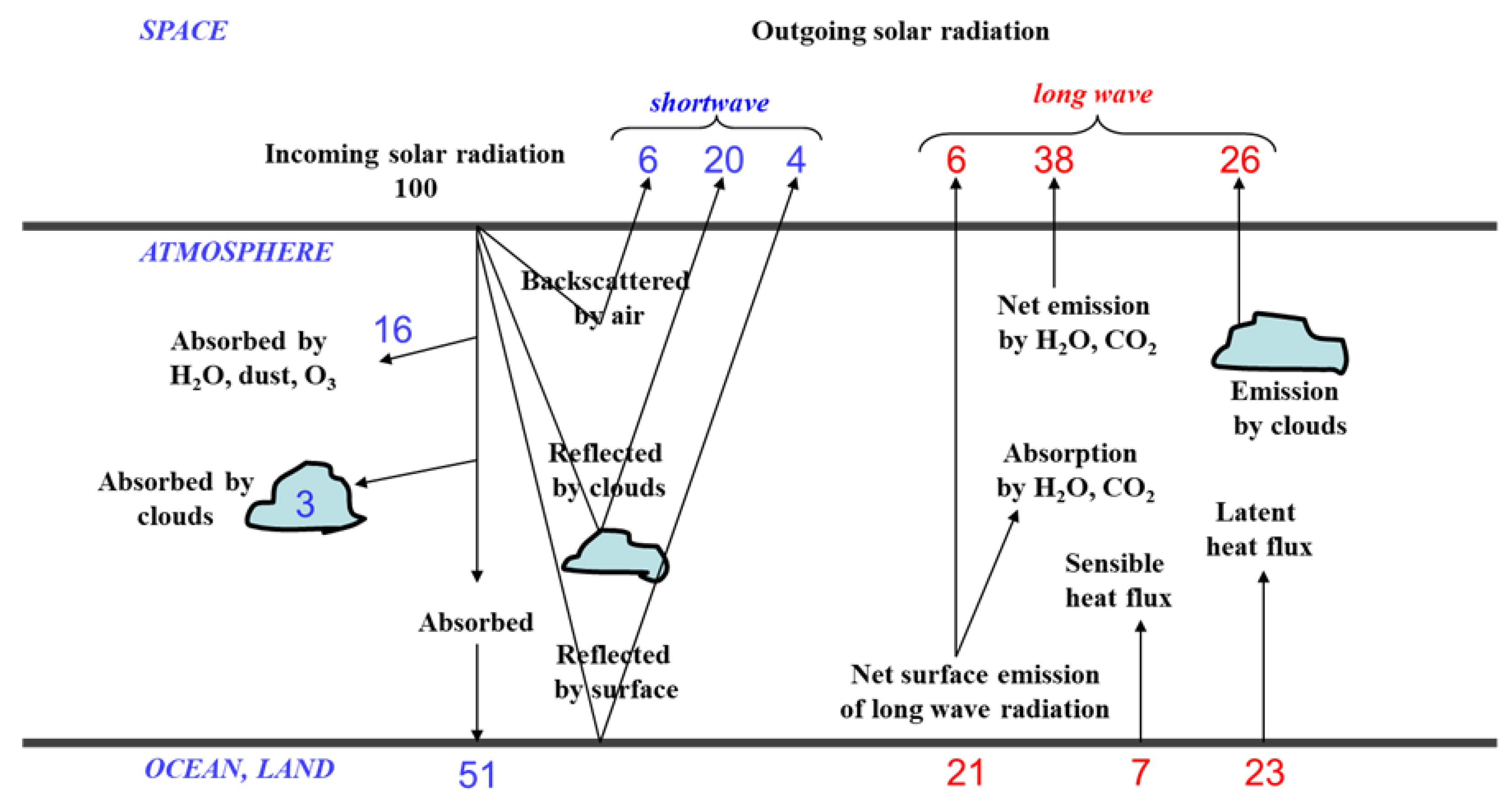


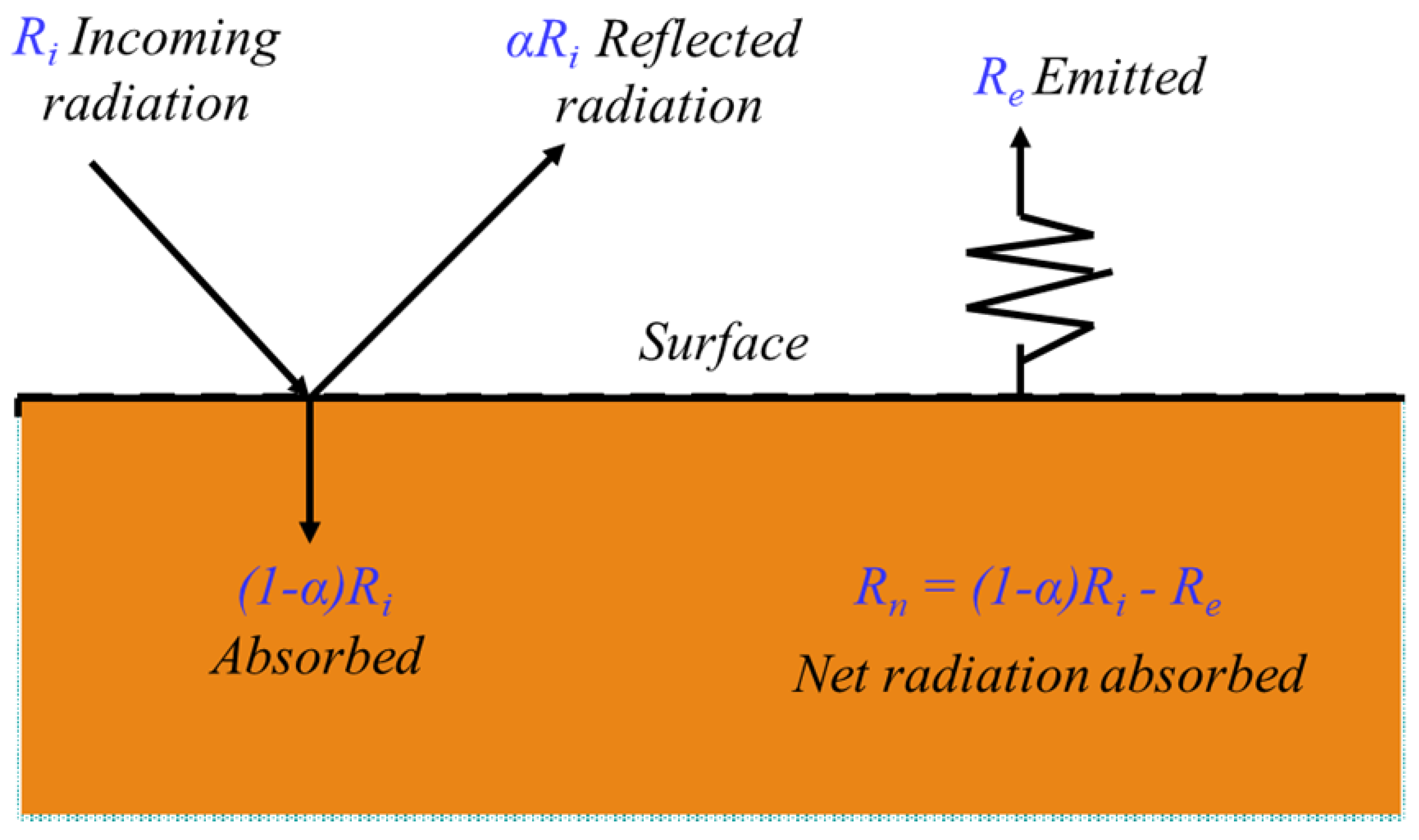
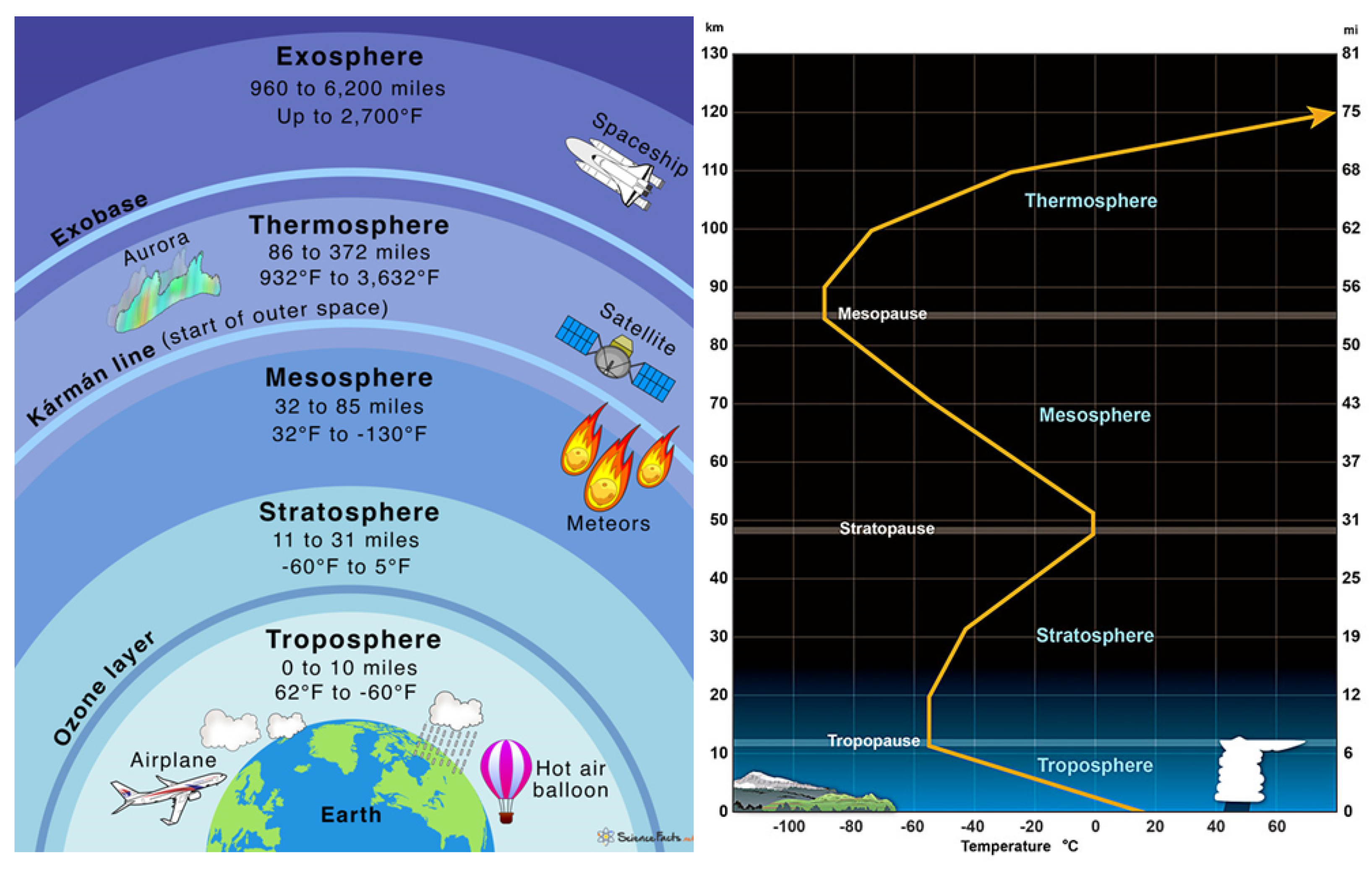



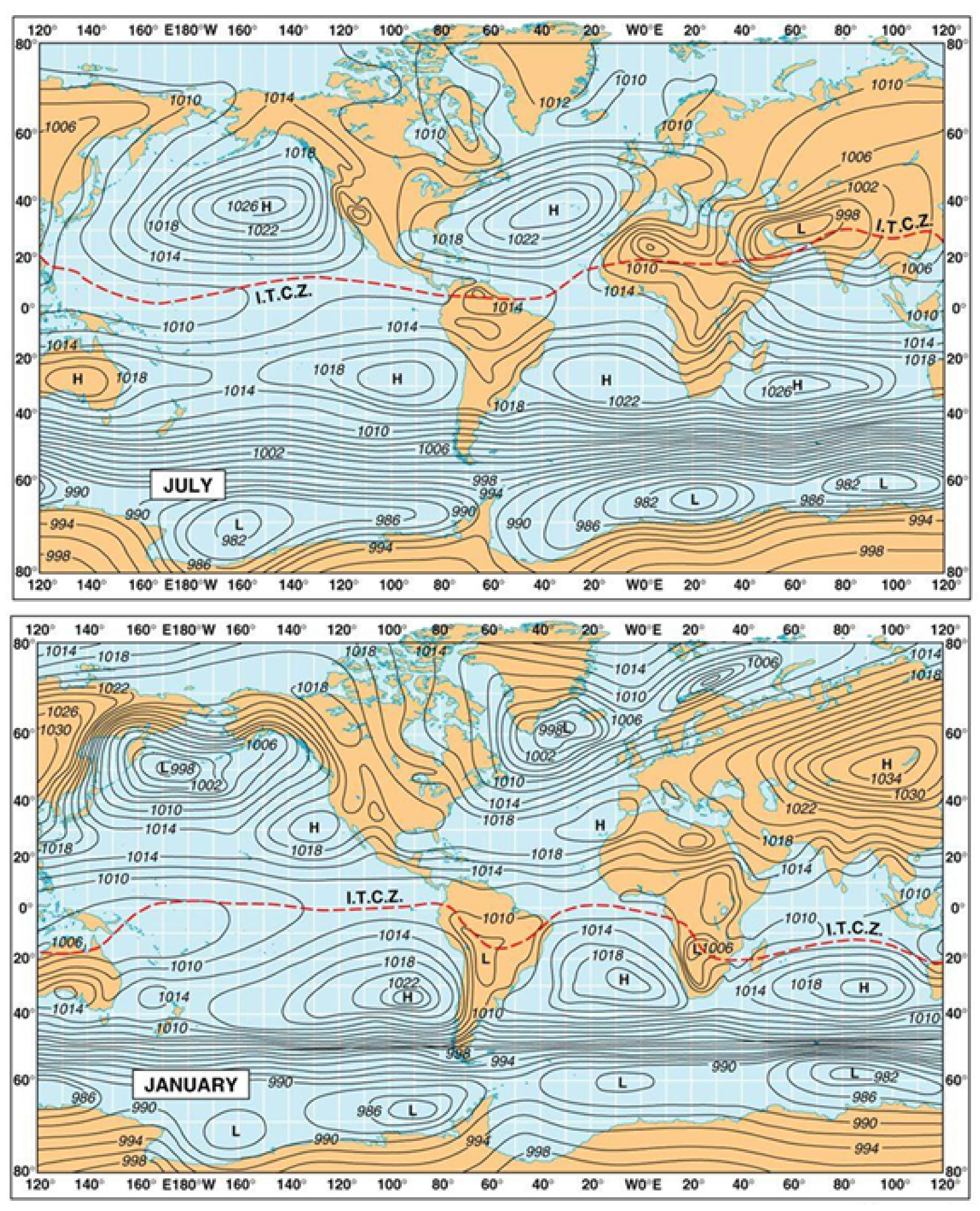
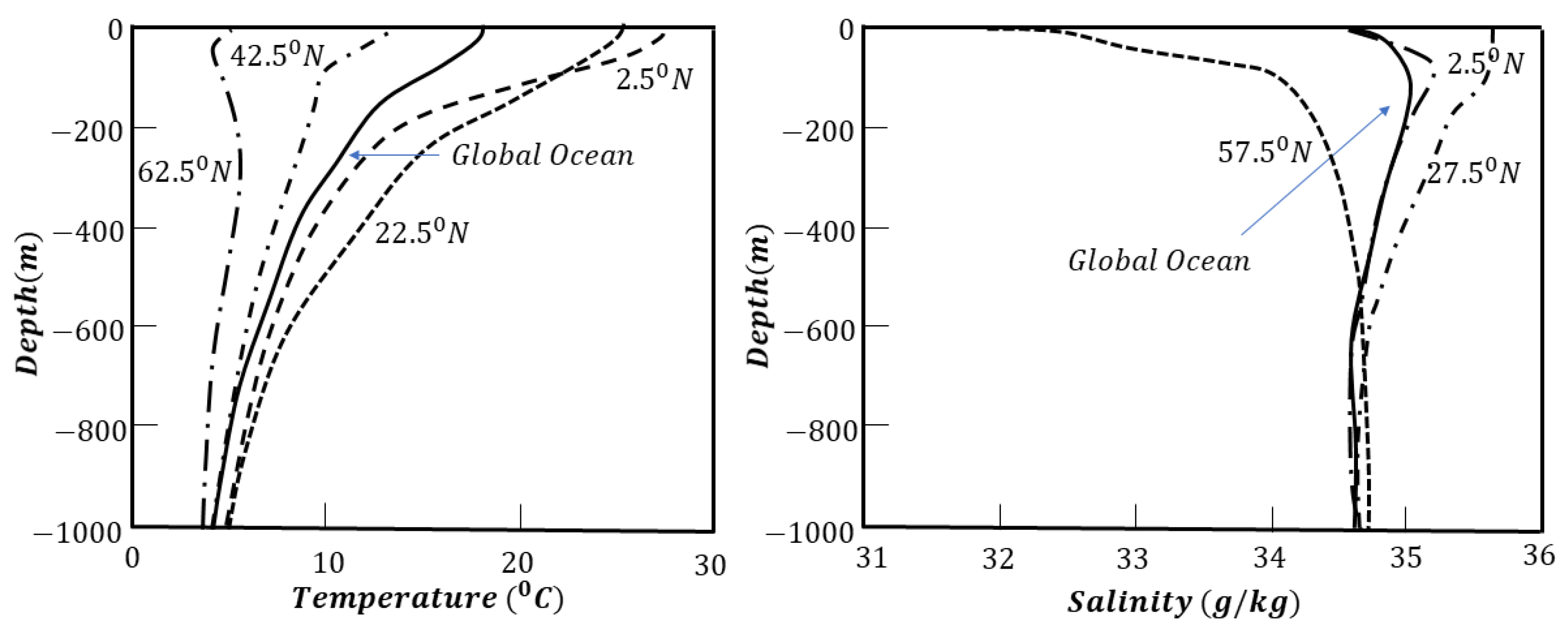


Publisher’s Note: MDPI stays neutral with regard to jurisdictional claims in published maps and institutional affiliations. |
© 2022 by the author. Licensee MDPI, Basel, Switzerland. This article is an open access article distributed under the terms and conditions of the Creative Commons Attribution (CC BY) license (https://creativecommons.org/licenses/by/4.0/).
Share and Cite
Sarker, S. Fundamentals of Climatology for Engineers: Lecture Note. Eng 2022, 3, 573-595. https://doi.org/10.3390/eng3040040
Sarker S. Fundamentals of Climatology for Engineers: Lecture Note. Eng. 2022; 3(4):573-595. https://doi.org/10.3390/eng3040040
Chicago/Turabian StyleSarker, Shiblu. 2022. "Fundamentals of Climatology for Engineers: Lecture Note" Eng 3, no. 4: 573-595. https://doi.org/10.3390/eng3040040
APA StyleSarker, S. (2022). Fundamentals of Climatology for Engineers: Lecture Note. Eng, 3(4), 573-595. https://doi.org/10.3390/eng3040040





